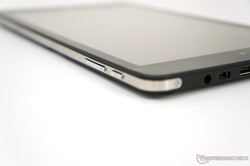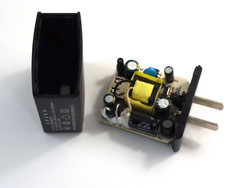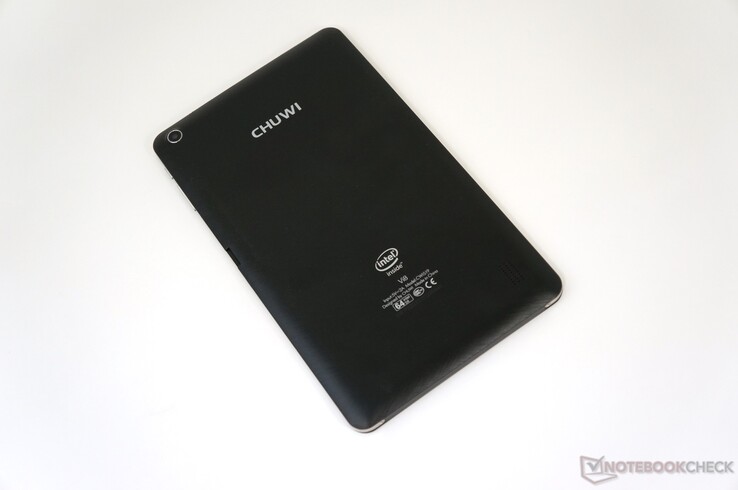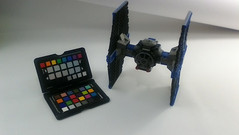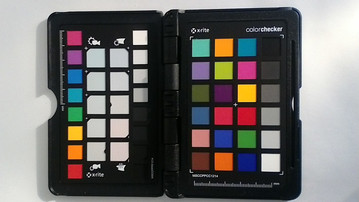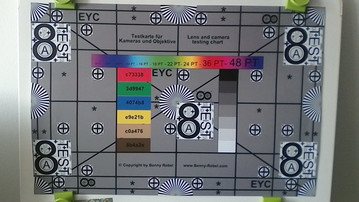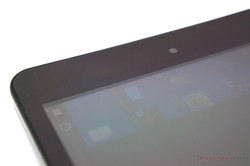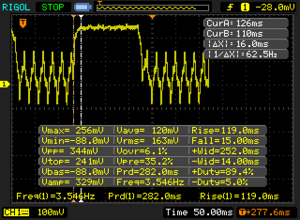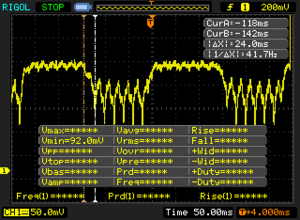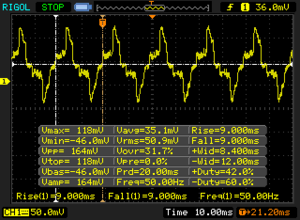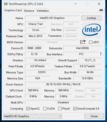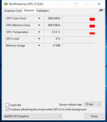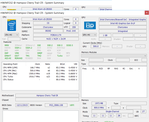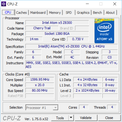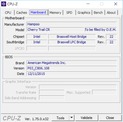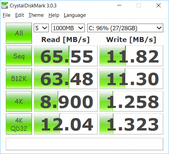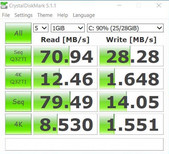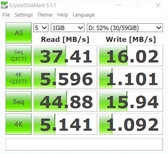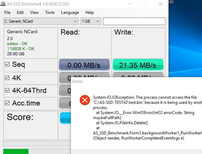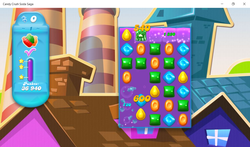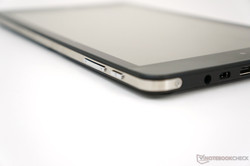Chuwi Vi8 Plus CWI519 Tablet Review
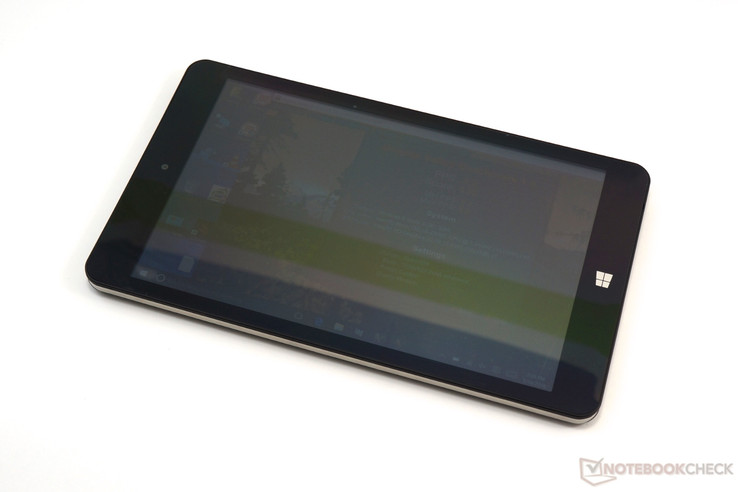
For the original German review, see here.
Not even 100 Euros (~$111) for a full-fledged Windows 10 tablet based on cutting-edge Intel technology? That is possible with the Chuwi V8 from China. The online retailer Gearbest.com sells the entry-level device for just 86.06 Euros (~$95) including shipping during the promotion period. The buyer gets appealing features like a 1280x800 IPS touchscreen, an Intel Atom x5-Z8300 SoC, and 32 GB of ROM. The tablet only has to compete with older Z3735 tablets even at its regular price, such as the following 8-inch Windows opponents:
Case
The Chuwi Vi8 comes in a plain plastic casing with metal strips glued and screwed to the sides as a highlight. The line-patterned plastic back provides good grip but is not particularly scratch resistant. Its stiffness does not set new standards, but it is throughout acceptable. The gaps are even, and only the screen protector applied ex-factory exhibits one minor flaw: There are two small air bubbles outside the screen surface area. The two buttons offer a well-defined pressure point and are incorporated firmly into the casing. An orange LED on the front-facing camera's right indicates whether the tablet is connected to an outlet and if it is recharging. Unfortunately, the blinking LED is somewhat distracting during use.
A side note: We found a hint about the barebone and its builder in HWInfo, namely Hampoo HC080. The corresponding data can be found on the Hampoo website, where an (optional?) GSM modem is also mentioned.
A throughout decent performance considering the price range of around 100 Euros (~$111).
Connectivity
The connectivity in 8-inch tablets is normally somewhat limited. The Chuwi Vi8 Plus offers even a bit more than some other tablets in this size category with a combined power and USB port, headset jack, micro-HDMI (1.4, 1080p maximum) and a micro-SD port. The USB port is implemented as a new Type-C, which allows inserting plugs both ways - very convenient. However, only a few accessories are available for it since the standard is still very new. Besides that, only one USB port for data and power limits connecting peripherals. Thus, the user will have to choose between recharging the battery and connecting an external storage device with standard USB adapters. The lateral micro-SD slot is convenient to use and an inserted card disappears completely into the casing. Unfortunately, a 16 GB Samsung micro-SD card was not identified reliably. For example, Windows could not find it after waking up from standby, making it necessary to remove and reinsert the card.
The HDMI port in our review sample did not function quite properly and had a slightly defective contact. However, that will unlikely apply to the entire series. It functioned impeccably after inserting the plug (and not touching it again) - including digital audio output.
The interface positioning does not give reason for complaint. All ports are sufficiently spaced in the upper edge. That will not be a problem thanks to automatic screen rotation via accelerometer.
We tested the SD card performance with a Toshiba Exceria Pro M401 (max 95 MB/s read, 80 MB/s write) and got 29 MB/s when copying 250 images (4 MB each) to the internal drive. That is below the average of 68 MB/s but up to now we had no tablet in our tests. Cheap Windows devices often perform worse (down to 11 MB/s).
| SD Card Reader - average JPG Copy Test (av. of 3 runs) | |
| Acer Aspire E5-722-662J | |
| Chuwi Vi8 Plus (CWI519) | |
| Acer Aspire ES1-521-87DN | |
| Acer Aspire One Cloudbook 11 AO1-131-C58K | |
Communication
The integrated Bluetooth 4.0 module functioned impeccably in the test and reliably connected to an external Logitech keyboard and mouse.
Windows does not reveal an exact model name for Broadcom's Wi-Fi module. It supports 802.1n in the 2.4 GHz frequency (our 5 GHz network was not found) and delivers a decent performance here. Its range, the identified networks and data speeds proved to be very good for a tablet. Connecting was always fast, and we did not observe any connection interruptions during the tests.
Accessories
The unadorned box only contains a power supply for the Chuwi Vi8 Plus (a US plug in our case) with a USB Type-A to Type-C cable. A USB Type-C to Type-A adapter is, unfortunately, not included, and it will have to be purchased as an accessory. The included instructions are more humorous than sensible since the translation makes a very make-do impression (see image gallery above).
"For the machines in a file or play when power consumption of large game is larger, the temperature of the machine is very high, so please don't long time continuous use machines, avoid the temperature is too high and appear crash etc anomaly."
Maintenance
The battery and innards of the Chuwi Vi8 are not accessible. Only 4 screws that additionally fix the glued metal strip are visible from the outside. However, they do not seem to keep the casing together. We did not make any further opening attempts since that would have likely also damaged the outer shell.
Warranty
Our review sample comes from the Chinese online shop Gearbest that states a general, one-year warranty on its website.
Cameras
Unfortunately, the installed rear-facing camera in the Chuwi tablet is virtually useless. Unfocused, inaccurate colors and a low resolution characterize the results. Our test photos were below average even in ideal light conditions. The front-facing camera was surprisingly useful for its intended use (videoconferencing).
Input Devices
Touchscreen
The installed touchscreen detected up to 10 fingers absolutely reliably and could even be used in Paint without major lags or inaccuracies. Inputs were occasionally delayed while browsing, but that could be due to the weak CPU and eMMC performance (especially when Windows 10 runs the virus scanner or looks for updates in the background).
Keyboard
Windows 10 standard keyboard is used as the onscreen keyboard in the Chuwi Vi8 Plus. Its layout is pleasant and was nice to use in the test. However, Windows 10 characteristics will sometimes still be a trial, such as the keyboard not fading in automatically or parts of the input field being covered. That functions considerably better and more reliably in IOS and Android.
Display
Despite the low price, we find an IPS screen with a resolution of 1280x800 pixels in the Chuwi Vi8. Its maximum brightness of 230 cd/m² in AC mode and 190 cd/m² in battery mode is, however, only enough for indoor use. On the other hand, the illumination is very homogeneous and the contrast is even very good thanks to the decent black level. The measurements were performed with the screen protector applied ex-factory.
| |||||||||||||||||||||||||
Brightness Distribution: 89 %
Center on Battery: 193 cd/m²
Contrast: 1064:1 (Black: 0.22 cd/m²)
ΔE ColorChecker Calman: 6.2 | ∀{0.5-29.43 Ø4.78}
ΔE Greyscale Calman: 5.9 | ∀{0.09-98 Ø5}
80.2% sRGB (Calman 2D)
77.7% sRGB (Argyll 1.6.3 3D)
51% AdobeRGB 1998 (Argyll 1.6.3 3D)
57.8% AdobeRGB 1998 (Argyll 3D)
78.1% sRGB (Argyll 3D)
57.3% Display P3 (Argyll 3D)
Gamma: 2.53
CCT: 7678 K
| Response Times | |
| Response Time Grey 50% / Grey 80% (sort by value) | |
| Chuwi Vi8 Plus (CWI519) (24, 26) | |
| Response Time Black / White (sort by value) | |
| Chuwi Vi8 Plus (CWI519) (14, 10.4) | |
| PWM Frequency (sort by value) | |
| Chuwi Vi8 Plus (CWI519) (50, 120) | |
* ... smaller is better
Reflections on the touchscreen, as well as its middling brightness, disturb outdoor use.
Brightness flickering below 50% was very evident in the test (PWM). That is not a major drawback since only 100 cd/m² is available in battery mode, and a higher brightness is usually selected anyway. As the response time diagram illustrates, a minor flickering is also measured in maximum brightness. Therefore, prolonged use could lead to eye problems in sensitive users; that, however, was noticed subjectively. The response times are on a good average even for an IPS panel.
Display Response Times
| ↔ Response Time Black to White | ||
|---|---|---|
| 24.4 ms ... rise ↗ and fall ↘ combined | ↗ 14 ms rise | |
| ↘ 10.4 ms fall | ||
| The screen shows good response rates in our tests, but may be too slow for competitive gamers. In comparison, all tested devices range from 0.1 (minimum) to 240 (maximum) ms. » 56 % of all devices are better. This means that the measured response time is worse than the average of all tested devices (20.2 ms). | ||
| ↔ Response Time 50% Grey to 80% Grey | ||
| 50 ms ... rise ↗ and fall ↘ combined | ↗ 24 ms rise | |
| ↘ 26 ms fall | ||
| The screen shows slow response rates in our tests and will be unsatisfactory for gamers. In comparison, all tested devices range from 0.165 (minimum) to 636 (maximum) ms. » 85 % of all devices are better. This means that the measured response time is worse than the average of all tested devices (31.6 ms). | ||
Screen Flickering / PWM (Pulse-Width Modulation)
| Screen flickering / PWM detected | 50 Hz | ≤ 50 % brightness setting | |
| ≤ 120 cd/m² brightness | |||
The display backlight flickers at 50 Hz (worst case, e.g., utilizing PWM) Flickering detected at a brightness setting of 50 % (120 cd/m²) and below. There should be no flickering or PWM above this brightness setting. The frequency of 50 Hz is very low, so the flickering may cause eyestrain and headaches after extended use. Flickering occurs at relatively low brightness settings, so extended use at this brightness setting or lower can cause eyestrain. In comparison: 53 % of all tested devices do not use PWM to dim the display. If PWM was detected, an average of 8111 (minimum: 5 - maximum: 343500) Hz was measured. | |||
Thanks to the IPS technology, the user will only have to count with brightness losses but not color deviations when altering the viewing angles. The Chuwi tablet does a good job here.
Performance
The modern 14 nm Atom SoC places the little 8-inch tablet in the entry-level sector of Windows devices. In terms of price, only models based on old Atom processors are present rivals. Despite a 64-bit processor, only a 32-bit Windows 10 is installed on the Chuwi tablet; probably a sanction by Microsoft for free Windows distribution.
Processor
The installed Intel Atom x5-Z8300 is a quad-core SoC designed for tablets. It was launched in March 2015, and it is built in the state-of-the-art 14 nm process using FinFETs. The SoC integrates four "Airmont" processor cores that clock at 1.44 - 1.84 GHz. The processor cores offer a comparable performance-per-megahertz as in the former generation, e.g. Atom Z3745. This is very clear in the Cinebench R10 32-bit single and multi tests. The performance of the Atom Z3735F in the IdeaPad Miix is similar. Higher clocked Z8500 and 8700-based devices can first outrun it.
System Performance
The modern Intel SoC can present its strengths in PCMark 8 Home. For example, the old Atom Z3735F in the IdeaPad Miix is clearly outperformed. Interestingly, the low-cost Chuwi tablet is even faster than the considerably more expensive Satellite Click 10 based on the same SoC. Z8500 and Z8700 devices are still up front. We also added an entry-level Core M and AMD's A8-6410 in our tests for comparison; both operate much faster.
The Chuwi tablet normally runs smoothly in routine use. However, perceptible lags are sometimes noticed - usually when something is still being processed in the background or the eMMC storage is loaded. That can still be considered "normal" in this performance category.
| PCMark 7 Score | 2220 points | |
| PCMark 8 Home Score Accelerated v2 | 1394 points | |
| PCMark 8 Work Score Accelerated v2 | 1202 points | |
Help | ||
Storage Device
Cutbacks have evidently been made in the integrated eMMC storage of the Chuwi tablet. The ascertained write rates are clearly slower than the data of other (more expensive) tablets, and the sequential read speed reminds us of bygone HDD times. By comparison: the 32 GB version in the Transformer Book T100TA achieves 109/43 MB/s (read/write) in CDM3. The considerably slower 64 GB version has a clear lead, at least in write, with 70/31 MB/s.
Graphics Card
The graphics card integrated in the x5-Z8300 has been clearly reworked compared with the former generation. Intel's HD Graphics comes from Intel's Gen8 architecture and has 12 shader clusters that clock at a maximum of 500 MHz. It supports DirectX 11.2 and is comparable with the graphics cores integrated in the Broadwell processors (e.g. HD Graphics 5300) technically. However, it requires considerably less energy.
The synthetic 3DMark 11 illustrates the clear performance leap over the former generation. Dell's Venue 8 Pro based on a Z3749D lags behind by 34%, for example. Other Z8300 and Z8500 Atoms have a slight edge. The x7-Z8700 in the Surface 3 and the Core M 5Y31 are, however, in another league.
| 3DMark 06 Standard Score | 2523 points | |
| 3DMark 11 Performance | 325 points | |
| 3DMark Cloud Gate Standard Score | 1426 points | |
Help | ||
Gaming Performance
The Atom lineup has not been designed for demanding 3D games. Despite the much improved graphics card compared with the former generation, even undemanding games are sometimes a challenge for the 8-inch tablet. Counter Strike GO only achieved an unplayable 12 FPS, and the popular DOTA 2 was not well-playable using 1024x768 and minimum details. 16 frames per second (from the SD card) was very jerky. 20 FPS was sometimes achieved in replays.
Undemanding games, such as Sid Meier's Ace Patrol (stable 30 FPS) or the preloaded Candy Crush presented smooth gameplay with good touchscreen control.
| low | med. | high | ultra | |
|---|---|---|---|---|
| World of Warcraft (2005) | 44 | |||
| World of Warships (2015) | 16.8 | |||
| Rocket League (2017) | 15.5 | |||
| Team Fortress 2 (2017) | 21.4 |
Emissions
System Noise
The Chuwi Vi8 does not produce annoying running noises since the installed Atom SoC can be cooled without a fan and a conventional HDD is not installed. We did not hear transistor whining or other noises from our review sample, either.
Temperature
The surface temperatures of the small 8-inch tablet remain within limits although the SoC is cooled passively. We did not observe an excessive temperature increase when it was not loaded heavily. The tablet usually remained agreeably cool. We only measured up to 49 °C when both the graphics card and processor's cores were loaded extremely at the same time.
However, the limits of the passive cooling are seen when looking at the internal data of the stress test. The CPU cores only still clocked at 480 MHz at 65 - 74 °C after 90 minutes of extreme load (Furmark and Prime95). The GPU clocked at 400 MHz from its possible 500 MHz. It clocked at just 280 MHz at 75 °C when only the graphics card was loaded via Furmark in a heated state. However, the four processor cores clocked stably at 1.6 GHz in the normal Cinebench 10 benchmark. We could not provoke the crash or anomaly the instructions warn about.
(-) The maximum temperature on the upper side is 47 °C / 117 F, compared to the average of 33.7 °C / 93 F, ranging from 20.7 to 53.2 °C for the class Tablet.
(-) The bottom heats up to a maximum of 49 °C / 120 F, compared to the average of 33.2 °C / 92 F
(+) In idle usage, the average temperature for the upper side is 26.8 °C / 80 F, compared to the device average of 30 °C / 86 F.
Speaker
Unfortunately, the audio jacks in the Chuwi Vi8 Plus fail miserably. The integrated microphone's heavy noise characteristic made it virtually useless in the test. The rear-sided speaker also only conveys a disappointing impression. The output is very quiet with just 70 dB(A), and the frequency diagram shows low quality that is also audible. Even YouTube videos are no fun. The headphone-out is better, but we perceived quiet static noise using an AKG K701 and AKG GHS 1. Though not a deal-breaker, it is not suitable for audiophiles. The port did not at all get along with a Bose in-ear headset. The sound output was absolutely distorted and the microphone did not function, either. Perhaps the speaker jack does not support a combo plug or it was another defect in our review sample.
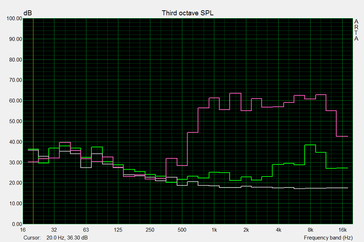
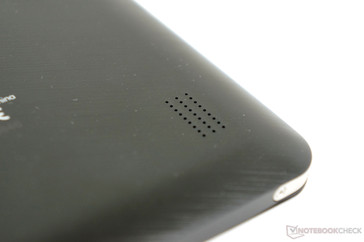
Energy Management
Power Consumption
The maximum of 12 watts that the Vi8 Plus drained from the outlet with the included USB power supply makes it quite frugal. Although we do not yet have extensive comparison measurements based on the new Metrahit Energy by Gossen in the tablet sector, Amazon's Fire HD 8 consumes more in idle, for example. It is on par with HP's Pro tablets still based on Bay Trail Atoms during load (and which need considerably more without load).
The standby power consumption is a relatively high 1.2 watts in the direct comparison (perhaps due to connected standby?). The power supply is satisfied with 0.14 watts in a turned-off-state and can therefore stay connected to the outlet without making the user feel guilty.
| Off / Standby | |
| Idle | |
| Load |
|
Key:
min: | |
Battery Runtime
The Chuwi Vi8 cannot exactly boast with the measured battery runtimes. It is situated at the very bottom in the tablet comparison with a battery life of 3 to 3.5 hours at 150 cd/m². The current average in our Wi-Fi test is over twice as high with 485 minutes. Unfortunately, the battery capacity cannot be read out in Windows, but we assume that it is a relatively small battery. Mobility is quite restricted since the little 8-incher also needs a relatively long time for recharging.
Pros
Cons
Verdict
The Chuwi Vi8 Plus is a low-cost entry-level tablet with the latest Atom technology made in China. Casing, performance and screen are compelling for the price. The biggest drawbacks are its short battery life and the poor speaker. That will clearly restrict the user in some application scenarios.
The tablet can be used as a full-fledged PC thanks to a full-scale Windows 10 version. However, the tablet experience in Android and IOS is considerably better by comparison. Especially the larger selection of touch apps has to be mentioned here. Their browsers also seem to be optimized a bit better than Microsoft's Edge in our opinion.
The USB Type-C port, unfortunately, only supports the slower USB 2.0 standard, and it sooner qualifies as a lightweight power supply due to the lack of accessories. That will likely change in the course of the year.
Gearbest offers the device presently for 86 Euros (~$95) including shipping in a promotional campaign. However, only devices with older Z3735G Atom SoCs are normally found even at the regular price of 120 Euros (~$133). Buyers willing to accept the above mentioned shortcomings and who can benefit from a full Windows 10 version should look closer at the Chuwi Vi8 Plus.
Update: Since the newsest Windows Updates (in Q4 2016), the WiFi of the tablet wont work properly anymore. Resetting the device enables wireless again, but only until Windows Updates installs the newest Windows 10 versions. It looks like Windows Update installs non working drivers automatically (still the same in late 2017). However, trying to install the original drivers also did not work with our unit.
Chuwi Vi8 Plus (CWI519)
- 02/16/2016 v5 (old)
Klaus Hinum




